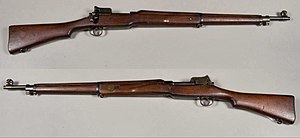This article includes a list of general references, but it lacks sufficient corresponding inline citations. (December 2010) |
| Rifle, .303 Pattern 1914 | |
|---|---|
 Pattern 1914 Enfield | |
| Type | Service rifle Bolt-action rifle Sniper rifle |
| Place of origin | United Kingdom |
| Service history | |
| In service | 1916 — Present |
| Used by | See Users |
| Wars | World War I Estonian War of Independence Spanish Civil War World War II Korean War Portuguese Colonial War 1958 Lebanon crisis Lebanese Civil War Soviet–Afghan War |
| Production history | |
| Designed | 1914–1915 |
| Produced | 1915–1917 |
| No. built | 1,235,298 total |
| Variants | Sniper (telescopic and unmagnified), grenade launcher, US M1917 rifle |
| Specifications | |
| Mass | 9 lb 6 oz (4.25 kg) unloaded |
| Length | 46.25 in (1,175 mm) |
| Barrel length | 26 in (660 mm) |
| Cartridge | .303 British |
| Calibre | .303 inch (7.7mm) |
| Action | Modified Mauser turn bolt-action |
| Rate of fire | Manual, as determined by skill of operator |
| Muzzle velocity | 2,380 ft/s (725 m/s) |
| Effective firing range | 800 yd (732 m) |
| Feed system | 5-round, stripper clip reloading |
The Rifle, .303 Pattern 1914 (or P14) was a British service rifle of the First World War period, principally manufactured under contract by companies in the United States. It was a bolt-action weapon with an integral 5-round magazine. It served as a sniper rifle and as second-line and reserve issue, until declared obsolete in 1947.[citation needed] The Pattern 1914 Enfield was the successor to the Pattern 1913 Enfield experimental rifle and the predecessor of the U.S. Rifle M1917 Enfield.